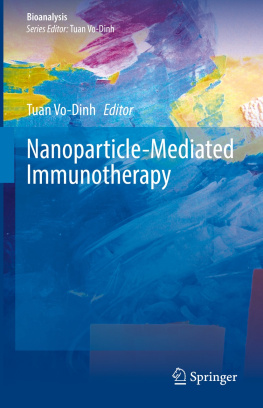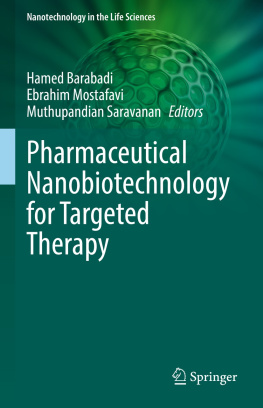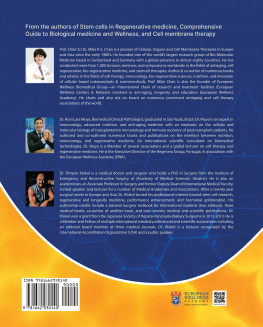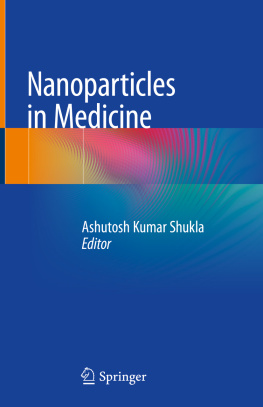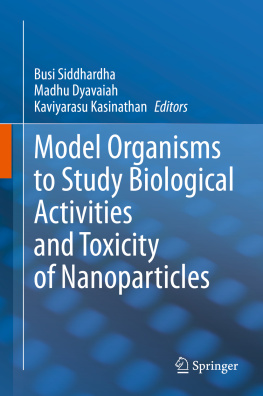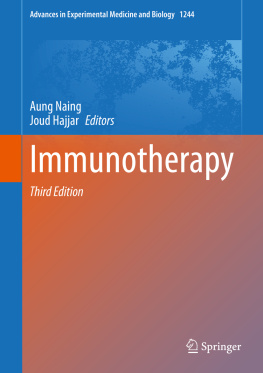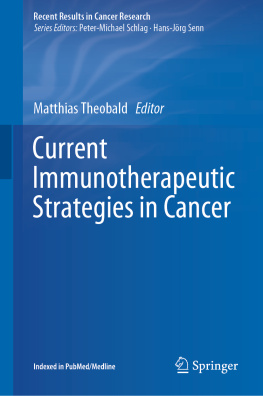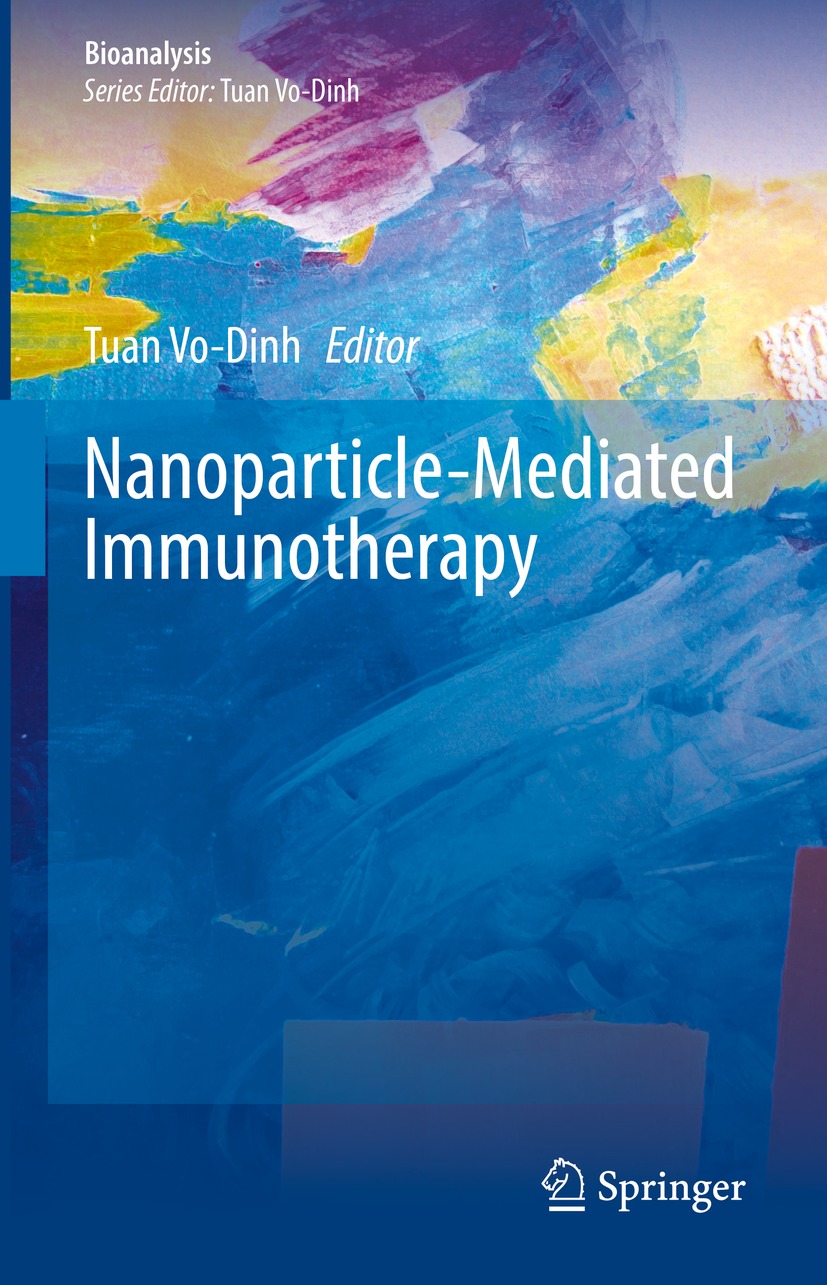Volume 12
Bioanalysis Advanced Materials, Methods, and Devices
Series Editor
Tuan Vo-Dinh
Fitzpatrick Institute for Photonics, Duke University, Durham, NC, USA
The book series on BIOANALYSIS: Advanced Materials, Methods, and Devices is intended to serve as an authoritative reference source for a broad, interdisciplinary audience involved in the research, teaching, learning, and practice of bioanalytical science and technology. Bioanalysis has experienced explosive growth due to the dramatic convergence of advanced technologies and molecular biology research, which has led to the development of entirely new analytical tools for chemistry, biochemistry, biology, pharmaceutical and clinical sciences, environmental, forensic and materials sciences. New approaches are developed to probe biomolecular and cellular processes as well as biological responses to implanted biomaterials and engineered tissues. Novel optical techniques using a wide variety of reporter gene assays, ion channel probes, and fluorescent probes have provided powerful bioanalytical tools for cell-based assays. The combination of molecular nanotechnology and various sensing modalities (optical, electrochemical, mass-based, etc.) opens the possibility of detecting and manipulating atoms and molecules using nano-devices, which have the potential for a wide variety of bioanalyses at the cellular level. This book series will present the most recent scientific and technological advances in materials, methods and instrumentation of interest to researchers, students, and manufacturers. The goal is to provide a comprehensive forum to integrate the contributions of chemists, physicists, biologists, engineers, materials scientists, and others involved in the analytical science and technology revolution that is reshaping molecular biology and medicine.
Examples of topics could include (but are not limited to):
Molecular spectroscopy (luminescence, absorption, scattering Raman, photoacoustics, OCT)
Non-linear spectroscopic techniques (CARS, CSRS, ISRS, photon echo, etc.)
Super-resolution techniques (STED, SIM, STORM, etc.)
Ultrafast spectroscopies (pico-, atto-, zepto-second regimes)
Nanosystems and technologies for bioanalysis (plasmonics nanosystems, quantum dots, etc.)
Near-field, far-field, and remote sensing techniques
Single-molecule and single-cell analysis
Biosensors and biochips
Quantum sensing and imaging
Robotics-guided biosensing, bioimaging, diagnostics and therapy
Isothermal sample amplification techniques (LAMP, SDA, NASBA, etc.)
Genomic and proteomic analysis, enzymatic assays, ligand binding assays
Genomics-enabled techniques (optogenetics, CRISPER, etc.)
Next-generation sequencing technologies
Bioanalytical sample preparation, micro-extraction and hyphenated separation techniques
Bioanalytical method validation
Data treatment methods in bioanalysis (artificial intelligence, machine learning, data fusion)
Contact for further information:
tuan.vodinh@duke.edu
loyola.dsilva@springer.com
More information about this series at http://www.springer.com/series/8091
Editor
Tuan Vo-Dinh
Fitzpatrick Institute of Photonics, Duke University, Durham, NC, USA
ISSN 2364-1118 e-ISSN 2364-1126
Bioanalysis
ISBN 978-3-030-78337-2 e-ISBN 978-3-030-78338-9
https://doi.org/10.1007/978-3-030-78338-9
Springer Nature Switzerland AG 2021
This work is subject to copyright. All rights are reserved by the Publisher, whether the whole or part of the material is concerned, specifically the rights of translation, reprinting, reuse of illustrations, recitation, broadcasting, reproduction on microfilms or in any other physical way, and transmission or information storage and retrieval, electronic adaptation, computer software, or by similar or dissimilar methodology now known or hereafter developed.
The use of general descriptive names, registered names, trademarks, service marks, etc. in this publication does not imply, even in the absence of a specific statement, that such names are exempt from the relevant protective laws and regulations and therefore free for general use.
The publisher, the authors and the editors are safe to assume that the advice and information in this book are believed to be true and accurate at the date of publication. Neither the publisher nor the authors or the editors give a warranty, expressed or implied, with respect to the material contained herein or for any errors or omissions that may have been made. The publisher remains neutral with regard to jurisdictional claims in published maps and institutional affiliations.
This Springer imprint is published by the registered company Springer Nature Switzerland AG
The registered company address is: Gewerbestrasse 11, 6330 Cham, Switzerland
Preface
The book Nanoparticle-Mediated Immunotherapy is intended to present recent scientific and technological advances in disease treatment at the intersection of nanotechnology and immunology. The book includes chapters grouped in two parts.
Part I contains chapters on basic principles and methods, including fundamental optical properties of nanoparticles and their effects on the immune system, strategies for immunotherapy from discovery to bedside, basic analysis, and imaging methods such as intravital microscopy to monitor anti-tumor immunological response, and theoretical studies of nanoparticle-mediated photothermal treatment for photoimmunotherapy.
Part II contains chapters describing various applications of nanoparticle-mediated immunotherapy. For instance, cancer immunotherapy uses the hosts inherent immune system to treat cancer and imparts a memory effect on the immune system that can inhibit cancer relapse. However, tumor cells often form their own immune mechanisms to interact with tumor microenvironments in order to escape from cancer immunotherapy. To enhance the therapeutic efficacy of cancer immunotherapy, various nanostructured materials have been developed to modulate such immune suppressive factors in the tumor microenvironments. Engineered nanoparticles have also been developed and used as immune-stimulating adjuvants to strengthen the immunogenicity of antigens. Immunotherapies could synergistically benefit from targeted thermal nanotherapies, especially when hyperthermia around the tumor bed is combined with precise thermal ablation of cancer cells. Photothermal therapy combined with adjuvant immunotherapy has been developed to produce synergistic outcomes. Copper sulfide nanoparticles as well as bacterium-mimicking liposomes have been designed as adjuvant delivery systems. Various inorganic nano-agents such as gold nanostructures, carbon nanotubes, graphene oxide, CuS nanoparticles, and MoS2 nanosheets with strong near-infrared (NIR) absorbance have been explored for in situ photoimmunotherapy. Other types of nanomaterials, including liposomes, polymeric nanoparticles, quantum dots, magnetic nanoparticles, mesoporous silica nanoparticles, and carbon-based nanomaterials have been utilized to deliver photosensitizers, aiming at enhancing their tumor accumulation and therapeutic efficacy. Upconversion nanoparticles, which can emit visible light under NIR light excitation, have been developed to allow NIR-mediated photodynamic therapy with improved tissue penetration. Plasmonic nanoparticles such as gold nanostars (GNS) have unique properties that allow them to amplify the optical properties of the excitation light and thus increase the effectiveness of light-based photothermal tumor ablation. The combination of GNS-mediated photothermal therapy with checkpoint blockade immunotherapy has shown great promise to address one of the most challenging problems in the treatment of metastatic cancer, i.e., achieve complete eradication of primary treated tumors as well as distant untreated tumors in murine models. Furthermore, GNS-mediated photoimmunotherapy has shown to elicit a long-term immunologic memory, ultimately inducing an anticancer vaccine effect.

